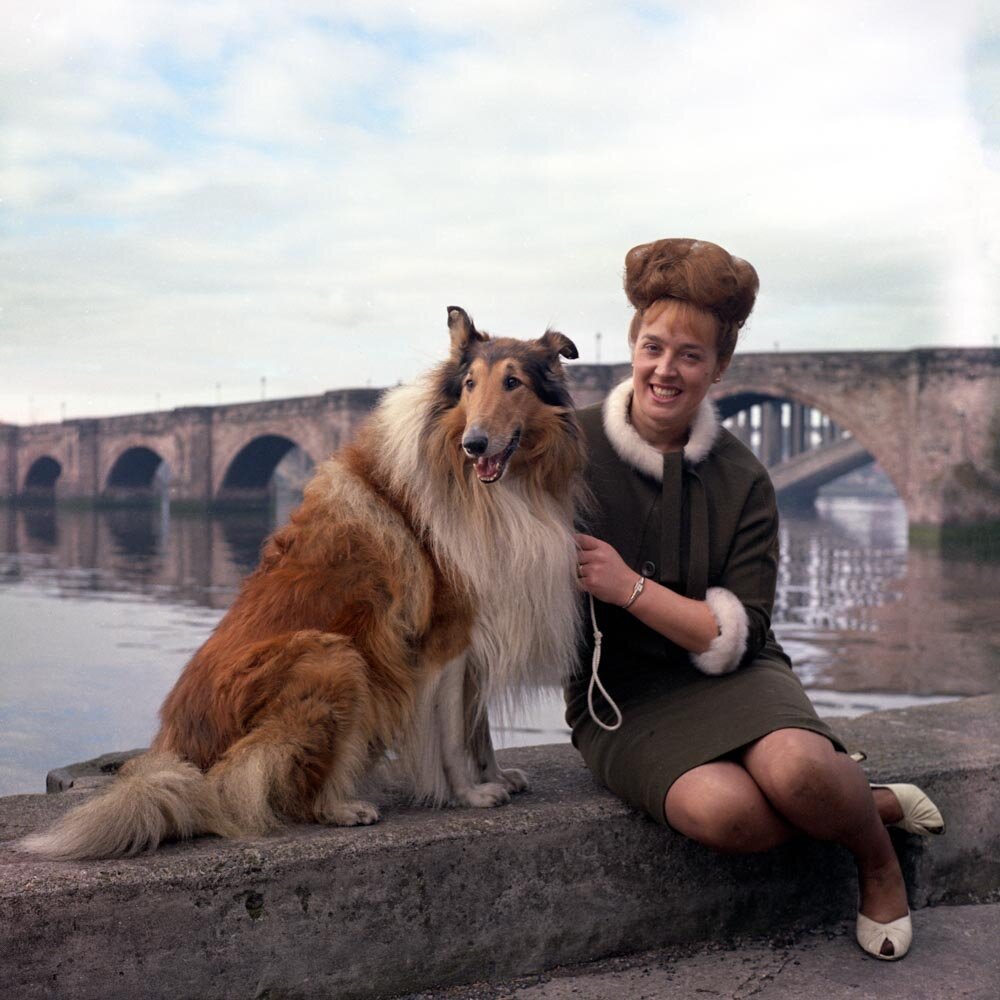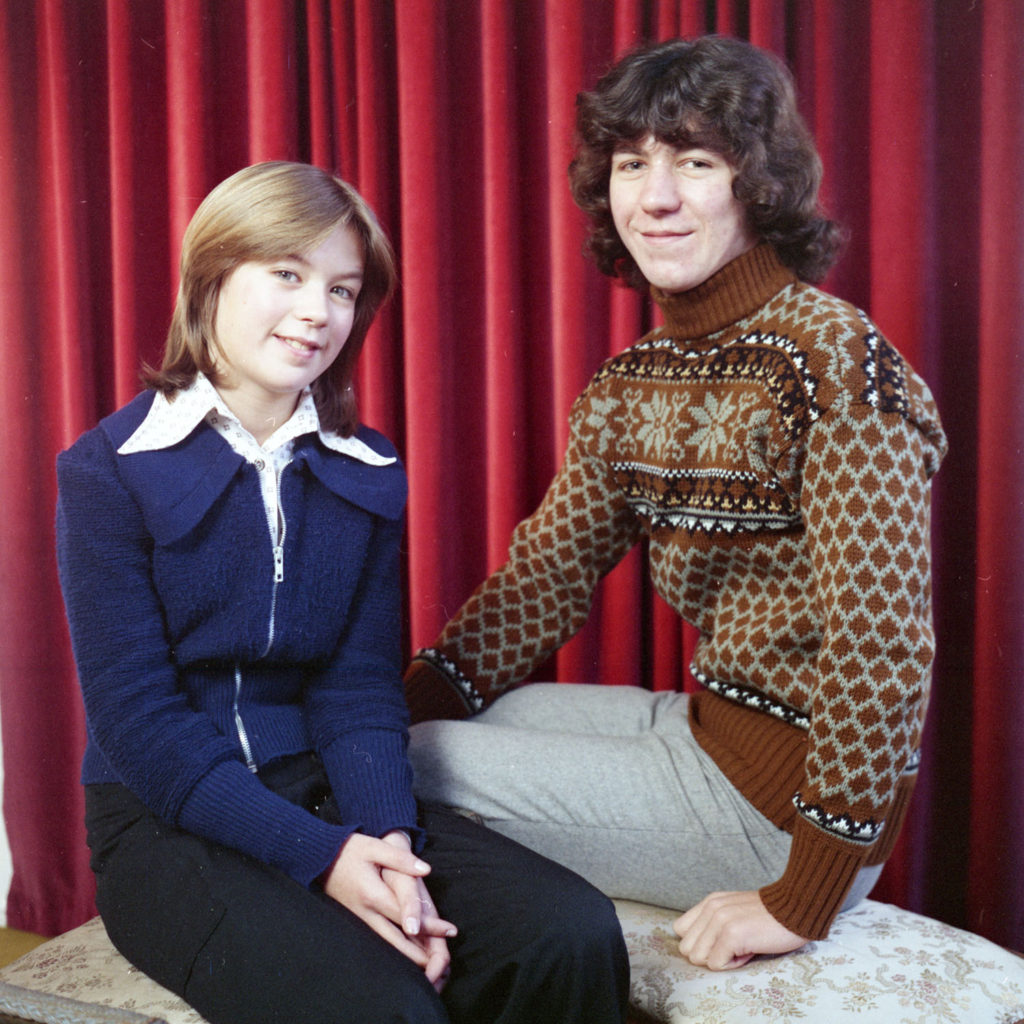Portrait Photographs, 1960s – 1970s
Reference: BRO 1944/2/88/7, BRO 1944/2/2067/13, BRO 1944/2, BRO 1944/2/2211/A/17
Suggested age groups: KS2, KS3, KS4, KS5, Lifelong Learners
Subject areas: Portraiture, Photography, 1960s/1970s Fashion
CONTEXT
Originally founded in 1951 as the Photo-News Service, the Photo Centre in Berwick was a staple of town life for over 65 years as a family-run press agency and photo studio.
Their premises at 17 Bridge Street had a well-equipped studio above the shop where commercial photography took place. The business also covered newsworthy events in the area and recorded family occasions and celebrations, marking milestones in the lives of several generations of townspeople.
The first photograph (BRO 1944/2/88/7), taken in 1965 is a portrait of Mrs Matthews and her dog sitting on Berwick Quayside with Berwick’s iconic bridges in the background.
The second photograph, (BRO 1944/2/2211/A/17), taken in 1975 is a studio photo of the Burns children.
The third photograph (BRO 1944/2/2067/13), taken in mid 1975 is the wedding of Carole Hartley and Robert Marshall.
The 1960s was a great period of change in fashion. Austerity was over and the “Swinging Sixties” had arrived. This was a time when people had more money to spend, allowing teenagers and young people to develop their own style which is reflected in the fashion. At the beginning of the decade, young people followed the lead of people like Twiggy and Mary Quant who favoured mini skirts, flat shoes and loose knitwear. The working woman and older women preferred the style of Jackie Kennedy Onassis, the wife of President Kennedy – shift dresses with matching jackets and accessories – hats and bags. All this had changed again by the end of the 1960s with the influence of the hippies and the flower power movement. Flares or bell bottoms as they were known were now the shape of trousers and dresses and clothes became floaty and long.
The 1970s introduced yet more changes and styles in fashion giving everyone even more options of how they could dress. At the beginning of the 1970s, platform shoes and “hot pants” were very popular, often in shiny fabric. All things denim became very popular – jeans, skirts, jackets and dungarees – and by the mid 1970s the peasant look had arrived – maxi or midi tiered skirts with floaty tops and wedge shoes. Other styles available were disco and punk, reflecting the music of the time. During this decade clothes were becoming more affordable, available in chain stores such as Topshop, C & A and in Ireland, Penneys, the original name for Primark.
Portraiture, or portrait photography, is one of the most common types of photography. In a portrait, the photograph captures the subject, for example a person or group of people, in a way that the face, facial features and facial expressions are made prominent. This does not mean that only the face and head can be visible in a portrait, a portrait can contain the subject’s full body.
A portrait photograph may be artistic, posed or candid, and can be taken in any environment, such as in a studio, outdoors or on location, and can be taken using studio lighting or natural/available light. Portraits can also fall into sub-genres, such as traditional portraits; family or pet portraits; wedding photographs; environmental portraiture – photographing the subject in their natural environment such as their workplace; fashion portraits; self-portraits; commercial portraits; headshots such as passport photographs or professional portraits used by actors; conceptual and fine art portraits.
ARTISTS BANK
Herb Ritts
American fashion and portrait photographer, known for photographing celebrities, models and cultural figures during the 1980s and 1990s. His work concentrated on black and white photography and portraits, often in the style of classical Greek sculpture, which emphasized the human shape.
Example portrait images: Jack Nicholson, Los Angeles 1986; Djimon with Octopus, Hollywood 1989; Eunice Shriver, Los Angeles 1995
Irving Penn
Best known for his fashion photography, Penn’s work also included portraits, often posing subjects against simple white or grey backdrops for simplicity; ethnographic photographs from around the world; still-life works of food, bones, bottles, metal, and found objects; and photographic travel essays.
Example portrait images: Sophia Loren, New York 1959; Issey Miyake, New York 1988; Pablo Picasso at La Californie, Cannes 1957
Jane Bown
British photojournalist and portrait photographer Jane Bown is known for her straightforward, naturally posed, black and white portraits usually taken with available light.
Example portrait images: Trevor Phillips, 1999; Edith Sitwell, 1959; Princess Anne, 1980
Steve McCurry
Portrait photographer and photojournalist Steve McCurry’s body of work spans conflicts, vanishing cultures, ancient traditions, and contemporary culture alike – yet always retains the human element.
Portrait portfolio: https://www.stevemccurry.com/galleries/portraits
Helen Warner
Helen Warner’s portraits are inspired by the myths and legends of Northern Ireland. She experiments with different materials and props to create emotive images bordering between dream and reality.
Portrait portfolio: http://www.helen-warner.com/photography
Lee Jeffries
The main subjects of Lee Jeffries’ photography are homeless people. He is one of the portrait photographers who has attempted to capture at least a bit of hope and faith in their eyes.
Portrait portfolio: https://lee-jeffries.co.uk/lost-angels
ACTIVITIES
ACTIVITY 1
Background
The 1960s was a great period of change in fashion. Austerity was over and the “Swinging Sixties” had arrived. This was a time when people had more money to spend, allowing teenagers and young people to develop their own style which is reflected in the fashion. At the beginning of the decade, young people followed the lead of people like Twiggy and Mary Quant who favoured mini skirts, flat shoes and loose knitwear. The working woman and older women preferred the style of Jackie Kennedy Onassis, the wife of President Kennedy – shift dresses with matching jackets and accessories – hats and bags. All this had changed again by the end of the 1960s with the influence of the hippies and the flower power movement. Flares or bell bottoms as they were known were now the shape of trousers and dresses and clothes became floaty and long.
The 1970s introduced yet more changes and styles in fashion giving everyone even more options of how they could dress. At the beginning of the 1970s, platform shoes and “hot pants” were very popular, often in shiny fabric. All things denim became very popular – jeans, skirts, jackets and dungarees – and by the mid 1970s the peasant look had arrived – maxi or midi tiered skirts with floaty tops and wedge shoes. Other styles available were disco and punk, reflecting the music of the time.
SEE
See: What is austerity?
See: Who were fashion icons for younger women during this time?
See: What styles did younger women wear during this time?
See: Who were fashion icons for older women during this time?
See: What styles did older women favour during this time?
See: How had fashion changed by the end of the 1960s?
See: What influenced the fashion change at the end of the 1960s?
See: What styles were in fashion during the 1970s?
THINK
Think: How did the styles of the 1960s and 1970s differ from each other?
Think: What influences the emergence of different fashion trends?
Think: How do politics and culture inspire fashion trends?
Think: How well do these photographs represent fashion from this time?
Think: How do these outfits differ from fashion today?
Think: Do you think there will be a revival of these styles?
Think: If there was a revival of these styles, how might they change?
Think: Can you see any influence from these styles in clothes today?
DO
Do: Create a mood board showing the different styles of fashion during the 1960s and 1970s.
Do: Create a second mood board narrowed down to a theme. You could choose to focus on a particular year, trend, style, gender, age group, designer or location. You could design either from the perspective of a designer working during the 1960s/70s or as someone reviving these styles.
Do: Create a series of designs inspired by your mood board.
Do: Choose one of your designs to make.
Do: Create an advertisement to promote your garment.
Do: Create a fashion photoshoot for your garment.
Do: Choose an outfit from the photographs and design or make an updated version of it.
Resources
ACTIVITY 2
Background
Portraiture, or portrait photography, is one of the most common types of photography. In a portrait, the photograph captures the subject, for example a person or group of people, in a way that the face, facial features and facial expressions are made prominent. This does not mean that only the face and head can be visible in a portrait, a portrait can contain the subject’s full body.
SEE
See: What is a portrait photograph?
See: What are the main characteristics of a portrait?
See: What type of portrait are these photographs?
See: How do these portraits differ from each other?
THINK
Think: What type of lighting do you think was used when shooting these photographs?
Think: Where do you think the lights were placed in comparison to the subject when artificial lighting was used?
Think: How might the locations have been chosen for each portrait?
Think: Do you think the studio used the same setup for each portrait or do you think this changed based on each portrait? Why?
Think: Are these photographs similar or different to portraits today?
Think: What does each portrait tell you about the subject?
Think: Do you think these photographs are good or bad examples of portraits?
Think: Do you think any of these photographs could be used in other ways other than as personal portraits? How? E.g., as commercial portraits, advertisements, etc.
Think: What did portraits look like prior to the 1960s? You could think about Victorian, Edwardian and War-era portraiture.
Think: When were photographic portraits first introduced?
Think: How has portraiture changed over time?
Think: What other styles of portraiture are there?
Think: Why do people get portrait photographs taken? Have these reasons changed over time?
DO
Do: Create your own series of portraits in the style of one of these portraits. For example, on location, in the studio or at an event.
Do: Create a series of portrait photographs in the style of a different photographer. You could choose a sub-genre of portraiture to explore.
Do: Experiment with how to show expression within portraits. You could think about how to express power, emotion, sensitivity and so on. What happens if you change the shooting angle or type of lighting used?
Do: Experiment with showing different personalities within portraiture. Think about how and where you position your subject, any props you might use and different facial expressions they may have.
Do: Edit or rework one of these photographs into another style. You could turn it into a magazine cover; create a pop-art style image; create a mixed-media image and draw, paint, print, or embroider sections.
Do: Create a self-portrait in the style of your choice. You could look at styles such as those used by Cindy Sherman, Claude Cahun, Andy Warhol or Jo Spence.
Do: Create your own portraiture series working in your own style with your own theme, showing either expression or personality.
Do: Experiment with collage by tearing sections of each photograph and putting them together to make a new image.
Do: Research early portraiture and early portrait photographers. You could look at Victorian, Edwardian and War-era images. Compare the Photo Centre portraits to early portraits. What are the similarities and differences? How do the poses and fashions differ?
Do: Experiment with taking a series of portraits in the style of early portraiture photographs.
Resources
OTHER ONLINE RESOURCES
Early Photography
Science Museum website, page about history of photography: https://www.scienceandmediamuseum.org.uk/objects-and-stories/history-photography
British Library website, page about invention of photograph (Henry Fox Talbot): https://www.bl.uk/collection-items/invention-of-photography
Bodleian website, biography of Henry Fox Talbot: https://talbot.bodleian.ox.ac.uk/talbot/biography/
Portraiture
Headshot London blog, What is Portraiture? – https://www.headshotlondon.co.uk/blog/what-is-a-portrait-photography/
History of Photography, Portraits – https://notquiteinfocus.com/2014/10/16/a-brief-history-of-photography-part-11-early-portrait-photography/
Tate, Portraiture – https://www.tate.org.uk/art/art-terms/p/portrait
How portrait photography evolved over time – https://www.scancafe.com/blog/the-evolution-of-portrait-photography
Photo Centre
Portrait of a Town exhibition: https://www.photocentreberwick.co.uk/portrait-of-a-town/work-and-industry
Photocentre workshop resources: https://www.photocentreberwick.co.uk/learning




